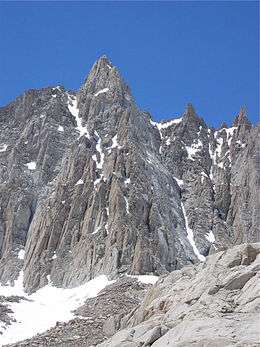Mount Muir
Mount Muir is a peak in the Sierra Nevada of California, 0.95 miles (1.5 km) south of Mount Whitney. This 14,018-foot (4,273 m) peak is named in honor of Scottish-born John Muir, a famous geologist, conservationist and founder of the Sierra Club. The southernmost section of the John Muir Trail contours along the west side of Mount Muir near its summit and ends on the summit of Mount Whitney.
| Mount Muir | |
|---|---|
 The East Face of Mount Muir | |
| Highest point | |
| Elevation | 14,018 ft (4,273 m) NAVD 88[1] |
| Prominence | 298 ft (91 m) [1] |
| Parent peak | Mount Whitney[2] |
| Listing |
|
| Coordinates | 36°33′53″N 118°17′28″W [6] |
| Geography | |
 Mount Muir California | |
| Location | Inyo and Tulare counties, California, U.S. |
| Parent range | Sierra Nevada |
| Topo map | USGS Mount Whitney |
| Climbing | |
| First ascent | 1919 by LeRoy Jeffers[7] |
| Easiest route | Hike and scramble from the west, class 3[8] |
Climbing
Among mountain climbers, a peak needs to meet certain criteria in order to be included in some lists. To be listed as an independent peak a summit must have 300 feet (91 m) of clean prominence. A reliable source gives Mount Muir's clean prominence as 298 feet,[1] and so the peak does not qualify for lists of fourteeners based on elevation and prominence.[9] It is included in other lists which do not depend on promince. Some lists are based on more subjective criteria and Mount Muir is included in the Sierra Peaks Section list,[3] the Western States Climbers list.[4] and the Vulgarian Ramblers, 13,800-Footers of the Contiguous USA list.[5][10]
The easiest approach is from the John Muir Trail just north of its junction with the Mount Whitney Trail in Sequoia National Park. The trail passes very near the summit and the climb involves a short stretch of difficult scrambling up the steep, boulder-strewn, western slope to the summit block, (class 3). A dayhike permit or a backcountry permit with a Whitney Zone stamp is required to hike the Mount Whitney Trail.[11]
The east side of Mount Muir, which is in the John Muir Wilderness, is a near-vertical cliff about 1,400 feet (430 m) high. The route on this side (the north side of the east buttress) was first climbed on July 11, 1935 by Nelson P. Nies and John D. Mendenhall. It is a roped climb, (class 4). The south side of the east buttress, also class 4, was first climbed on September 1, 1935, by Arthur B. Johnson and William Rice.[8]
References
- "Mount Muir, California". Peakbagger.com. Retrieved 2011-05-31.
- "Key Col for Mount Muir". Peakbagger.com. Retrieved 2016-03-23.
- "Sierra Peaks Section List" (PDF). Angeles Chapter, Sierra Club.
- "Western States Climbers List". Climber.org. Retrieved 2016-03-24.
- "Vulgarian Ramblers 13,800-Footers of the Contiguous USA". Retrieved 2016-03-23.
- "Mount Muir". Geographic Names Information System. United States Geological Survey. Retrieved 2011-05-31.
- Secor, R.J. (2009). The High Sierra Peaks, Passes, and Trails (3rd ed.). Seattle: The Mountaineers. p. 67. ISBN 9780898869712.
- Roper, Steve (1976). The Climber's Guide to the High Sierra. San Francisco: Sierra Club Books. p. 312. ISBN 0-87156-147-6.
- "What Happened to Mt. Muir?". VulgarianRamblers.org.
- "Mt. Muir Details". VulgarianRamblers.org. Retrieved 2016-03-23.
- "Mount Muir". SummitPost.org. Retrieved 2011-05-31.